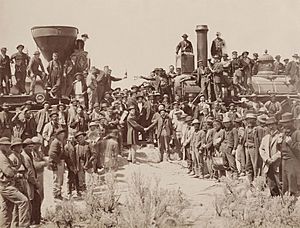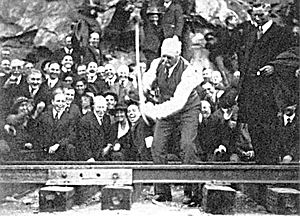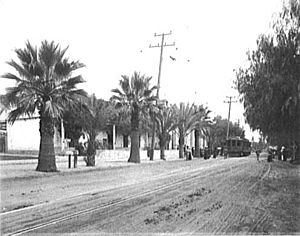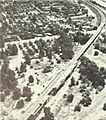History of rail transportation in California facts for kids

Imagine California as a lonely outpost on the Pacific Ocean! Before 1869, it was pretty isolated from the rest of the United States. But then, something amazing happened: the Transcontinental Railroad was finished. This huge railway connected California to the eastern states, changing everything.
This new connection helped California grow in many ways. It became more connected socially, politically, and economically. Over time, more train systems developed, making travel and trade even easier.
In the mid-1900s, fewer people rode trains as cars and highways became popular. But now, trains are making a comeback! Services like Metrolink, Coaster, Caltrain, and Amtrak California are busy again. In 2008, Californians even voted to help fund a new high-speed rail line.
Contents
Why Trains Were Needed
Before trains, traveling to California was a huge adventure. If you were on the East Coast, sailing around South America took five to eight months! That's like a whole school year on a boat.
Another way was to sail to Panama, then travel through the jungle by canoe and mule for a week. After that, you'd wait for another ship to San Francisco. Many people also traveled overland across the United States, often on the California Trail. All these journeys had serious dangers, like shipwrecks, diseases, or attacks.
Connecting the Country
The very first "inter-oceanic" railroad that helped California was built in 1855 across the Isthmus of Panama. This Panama Railway cut the difficult week-long jungle trip down to just one day! With more steamships and this new railway, traveling through Panama became the main way for people and valuable goods (like gold) to go between California and the East Coast.
California truly joined the rest of the country on May 10, 1869. This was when the "last spike" was hammered in at Promontory, Utah. It connected the tracks of the Central Pacific Railroad and Union Pacific Railroad, completing the First Transcontinental Railroad. Before this, California only had a few small local train lines, like the Sacramento Valley Railroad.
Now, a 1,600-mile trip from Nebraska took only a few days instead of months! This quickly changed the American Old West from a wild, farming area into a powerful place with cities and industries. It also kicked off huge economic growth because of all the new chances in the region.
In the four years after the Golden Spike ceremony, the amount of train tracks in the U.S. doubled! By the early 1900s, four more transcontinental routes in the U.S. and one in Canada were built. These new lines connected not just the coasts but also important areas in between. For the first time, almost the entire country was reachable by train, making a national economy possible.
The government helped build these railroads with land and loans. But private investors actually built most of the tracks. As train lines pushed into new areas, they opened up huge lands that were once empty. Railroads helped create countless towns, find rich minerals, and reach fertile farmlands. They also created new markets for goods from the East.
The most important thing trains brought to California was people. By cutting cross-country travel to as little as six days, men could bring their families with them when they moved west. Over time, trains also connected communities within California.
"Transportation decides where people live," said John D. Spreckels, an early California railroad leader. He believed people needed to get to places quickly, comfortably, and cheaply. Spreckels helped build the San Diego Electric Railway in 1892, which helped San Diego grow. Henry E. Huntington, another railroad leader, did the same for Los Angeles and Orange Counties with his Pacific Electric Railway.
Spreckels' biggest challenge was giving San Diego its own direct train link to the rest of the country. This was the San Diego and Arizona Railway, finished in 1919. The Central Pacific Railroad started this trend by offering low fares and selling land to pioneers to encourage settlement.
In 1885, the Atchison, Topeka and Santa Fe Railway built its own line across the country, choosing Los Angeles as its western end. This broke the Southern Pacific Railroad's near-total control over trains in California. The Santa Fe's arrival in Southern California caused a huge economic boom and a fierce price war with the Southern Pacific. It also led to Los Angeles' famous real estate "Boom of the Eighties."
The Santa Fe lowered ticket prices from Kansas City, Missouri to Los Angeles from $125 to just $15, and even to a dollar on one day! The Southern Pacific quickly matched these prices. This led to a huge increase in land buying. Railroads even offered free daily trips with lunch and entertainment to get people to buy land.
Sadly, this land boom also attracted dishonest people who sold land that didn't exist or had unclear ownership. But major advertising campaigns by the Southern Pacific, Santa Fe, and Union Pacific helped turn Southern California into a big tourist spot. They also sparked interest in farming there. News of good jobs, high pay, and California's nice climate spread, bringing many people from states like Iowa and Kansas. Even though the real estate bubble burst in 1889, the many new towns, farms, and citrus groves changed Southern California forever.
The completion of the First Transcontinental Railroad was a huge moment for America. It also created a powerful railroad empire that shaped California for many years. Despite some problems, California gained countless benefits from its connection with the railroad companies, which truly put the state "on the map."
Farming and Trains
California is famous for its many kinds of fruit trees. But originally, only wild berries grew there. Spanish missionaries brought fruit seeds from Europe, like orange, grape, apple, peach, pear, and fig.
Mission San Gabriel Arcángel, near what is now Los Angeles, was founded in 1771. Years later, it saw the start of California's citrus industry with the first big orchard. Soon after the transcontinental railroad was finished, small amounts of California crops were shipped east in special ventilated boxcars. Then, the invention of the iced refrigerator car (or "reefer") allowed much more produce to be shipped further distances.
For years, oranges were rare and seen as a luxury. But in the 1870s, new types of California oranges were created, like the Navel and Valencia. These could be grown all year. By 1890, there was a huge market for California citrus outside the state, starting the "Orange Era."
As the demand for farm goods grew, the Santa Fe built a huge fleet of refrigerator cars. In 1906, the Southern Pacific and Union Pacific created the Pacific Fruit Express. Now, half of California's farm products could be sent across the country, with western railroads carrying almost all the perishable fruit. By the time of the Great Depression, California, Arizona, and Oregon led U.S. farming. With crops like wheat, sugar beets, olives, and lettuce, California became known as the nation's "produce basket."
Oil Discovery
As farming grew and new train lines were built, new towns appeared and old ones expanded. Farming success led to post offices, schools, churches, stores, and related businesses like packing houses. The discovery of brea, or tar, in Southern California led to an oil boom in the early 1900s.
Railroad companies quickly learned that shipping oil in wooden barrels by boxcar was too expensive. So, they developed steel cylindrical tank cars that could carry large amounts of liquid anywhere. By 1915, moving petroleum products was a very profitable business for western railroads.
The Southern Pacific was the first western railroad to try using oil instead of coal to power its locomotives in 1879. By 1895, oil-burning locomotives were used on many Southern Pacific routes, and also on the California Southern and Great Northern Railway. This change not only gave railroads a cheap and plentiful fuel source but also created new markets by using the growing petroleum industry. Switching from coal to oil also helped the Southern Pacific solve the problem of heavy smoke in the tunnels of the Sierra Nevada. Thanks to the railroads, California was once again in the spotlight!
California for Tourists
The railroads were among the first to promote California tourism starting in the 1870s. They wanted more people to ride their trains and to create new markets for their freight business. About sixty years later, the Santa Fe led a new wave of leisure travel to the West Coast with famous trains like the Chief and Super Chief. The Southern Pacific followed with their Golden State and Overland Flyer trains, and the Union Pacific with its City of Los Angeles and City of San Francisco. The huge popularity of Helen Hunt Jackson's 1884 novel Ramona especially boosted tourism, just as the Southern Pacific's Southern California lines opened.
The Santa Fé especially embraced the feeling of the American Southwest in its ads and operations. Their routes and excellent service became very popular with film stars in the 1930s, 40s, and 50s, adding to the Hollywood mystique. This "golden age" of railroading eventually ended as traveling by car and airplane became cheaper and more popular.
Rules and Regulations
The economic "explosion" in California also led to some corruption. This caused people to demand new rules and regulations. Early examples include decisions from the Granger cases in the 1870s. California's Constitution of 1879 also created the first Railroad Commission, though it wasn't very effective at first.
In 1886, the U.S. Supreme Court made a ruling that said a corporation could be seen as an American citizen, with many of the same rights. This made it hard for states to pass laws that would make corporations answerable to the people. Later, the Stetson-Eshelman Act of 1911 allowed state governments to set shipping prices. In 1911, California's new government created a second, more effective Railroad Commission.
Trains in the 1900s
In the early 1900s, private companies ran most passenger trains in California. The San Diego Electric Railway, started by John D. Spreckels in 1892, was the main transit system in San Diego. In Los Angeles, Henry Huntington created the Los Angeles Railway (Yellow Car system) and the Pacific Electric (Red Car system) in 1901. Francis Marion Smith then created the Key System in 1903 to connect San Francisco with the East Bay.
However, all these streetcar systems, and others across the state, started to decline in the 1940s. This was because California's car culture and freeway network grew. Many of these systems were eventually taken over and dismantled, replaced by bus service.
Starting in the 1970s, worries about the environment and traffic led to a new interest in urban passenger trains, especially light rail networks. The San Diego Trolley opened in 1981. Then came the Sacramento Regional Transit and Santa Clara Valley Transportation Authority light rail systems in 1987, and the Los Angeles Metro Rail in 1990.
Planning for a modern, fast urban train system in California began in the 1950s. California's government created a group to study the Bay Area's long-term transportation needs. Based on their report, the state created the San Francisco Bay Area Rapid Transit (BART) District in 1957 to build a rapid transit system to replace the Key System. BART started passenger service in 1972. The Red rapid transit line of the Los Angeles Metro Rail began construction in 1986, and its first part opened in 1993.
One urban system that wasn't badly affected by the streetcar decline was the San Francisco Municipal Railway (MUNI) in San Francisco. Its five busy streetcar lines ran partly through tunnels or on their own special tracks, so they couldn't be easily changed to bus lines. These lines kept running for decades. When new stations were planned for the Market Street Subway tunnel (with BART below and MUNI above), they needed high platforms. This meant the old streetcars couldn't be used. So, MUNI ordered new light rail vehicles, and Muni Metro began service in 1980.
Caltrans and Amtrak teamed up to form Amtrak California in 1976. This intercity service now has three lines: the Capitol Corridor, connecting the Bay Area with Sacramento; the Pacific Surfliner, serving coastal Southern California between San Diego and San Luis Obispo; and the San Joaquin, connecting Central Valley communities with the Bay Area.
In 1977, Southern Pacific wanted to stop the Peninsula Commute, a commuter train service between San Jose and San Francisco, because it was losing money. Instead, Caltrans started to pay for it and later renamed it Caltrain in 1987. Southern Pacific later sold some of its tracks in 1991. These tracks became the core of the Metrolink commuter rail network when it opened a year later. The Coaster commuter rail, connecting San Diego and Oceanside, started service in 1995 on tracks that used to belong to the Atchison, Topeka and Santa Fe Railway. The Altamont Commuter Express, connecting San Joaquin County and the Bay Area, opened in 1998.
The Southern Pacific was bought by Union Pacific in 1996. In the same year, the Atchison, Topeka and Santa Fe Railway merged with the Burlington Northern Railroad to form BNSF Railway. So, today, the two main railroads in California are Union Pacific and BNSF.
Trains in the 2000s
A big question in California is whether to keep building more freeways or focus on improving public transportation in cities. The Sprinter light rail system started service in 2008, connecting cities in northern San Diego County. Also, several public train expansion plans are either being built or planned. These include the Silicon Valley BART extension, LA Metro Rail's Purple Line Extension and Gold Line Foothill Extension, Muni's E Embarcadero, the San Diego Trolley's Mid-Coast extension project, and the Sacramento RT Light Rail's Blue Line extension project.
The California High Speed Rail Authority was created in 1996. Its goal is to build a 700-mile (1127 km) rail system. This system would provide a super-fast link between California's four major cities. It would allow travel between Los Angeles's Union Station and the San Francisco Transbay Terminal in just two and a half hours! In November 2008, voters approved Proposition 1A, which set aside $9 billion to help pay for the project. In 2012, the California government approved funding for the first part of construction. The High Speed Rail Authority believes the first stages won't be finished until 2021.
Images for kids
-
Pacific Electric Red Cars at the Pacific Electric Building, around 1910
-
Drawings for the Yerba Buena Tunnel, showing the San Francisco–Oakland Bay Bridge's original setup with a double-track interurban railway (bottom right). November, 1933
-
A California Western Railroad train, 2009
-
Metrolink Antelope Valley Line next to Interstate 5, 2014
-
A BNSF train on the Tehachapi Loop, 2011
-
The BART station at San Francisco International Airport, which opened in 2003
-
An LA Metro Rail overpass over the Foothill Freeway built for the Gold Line Foothill Extension
-
SMART Nippon Sharyo DMU crossing the Haystack Landing Bridge over the Petaluma River

















